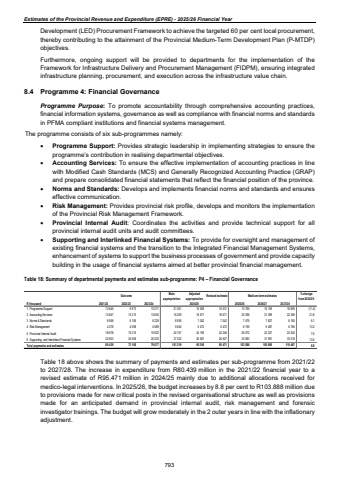Page 814 - Demo
P. 814
Estimates of the Provincial Revenue and Expenditure (EPRE) - 2025/26 Financial Year Development (LED) Procurement Framework to achieve the targeted 60 per cent local procurement, thereby contributing to the attainment of the Provincial Medium-Term Development Plan (P-MTDP) objectives. Furthermore, ongoing support will be provided to departments for the implementation of the Framework for Infrastructure Delivery and Procurement Management (FIDPM), ensuring integrated infrastructure planning, procurement, and execution across the infrastructure value chain. 8.4 Programme 4: Financial Governance Programme Purpose: To promote accountability through comprehensive accounting practices, financial information systems, governance as well as compliance with financial norms and standards in PFMA compliant institutions and financial systems management. The programme consists of six sub-programmes namely: %uf0b7 Programme Support: Provides strategic leadership in implementing strategies to ensure the programme%u2019s contribution in realising departmental objectives. %uf0b7 Accounting Services: To ensure the effective implementation of accounting practices in line with Modified Cash Standards (MCS) and Generally Recognized Accounting Practice (GRAP) and prepare consolidated financial statements that reflect the financial position of the province. %uf0b7 Norms and Standards: Develops and implements financial norms and standards and ensures effective communication.%uf0b7 Risk Management: Provides provincial risk profile, develops and monitors the implementation of the Provincial Risk Management Framework.%uf0b7 Provincial Internal Audit: Coordinates the activities and provide technical support for all provincial internal audit units and audit committees. %uf0b7 Supporting and Interlinked Financial Systems: To provide for oversight and management of existing financial systems and the transition to the Integrated Financial Management Systems, enhancement of systems to support the business processes of government and provide capacity building in the usage of financial systems aimed at better provincial financial management. Table 18: Summary of departmental payments and estimates sub-programme: P4 %u2013 Financial Governance Outcome Main appropriationAdjusted appropriation Revised estimate Medium-term estimates % change from 2024/25R thousand 2021/22 2022/23 2023/24 2025/26 2026/27 2027/281. Programme Support 13 845 9 973 13 271 21 351 15 509 15 531 13 765 16 159 16 893 (11.4)2. Accounting Services 13 847 13 215 13 834 15 209 16 671 16 671 20 298 21 399 22 369 21.83. Norms & Standards 6 958 6 108 6 229 6 936 7 042 7 042 7 475 7 827 8 183 6.14. Risk Management 4 278 4 098 4 589 5 644 5 472 5 472 6 195 6 487 6 784 13.25. Provincial Internal Audit 18 678 15 216 15 922 24 747 24 195 24 248 26 072 22 227 23 240 7.56. Supporting and Interlinked Financial Systems 22 833 24 558 25 232 27 332 26 507 26 507 30 083 31 591 33 018 13.5Total payments and estimates 80 439 73 168 79 077 101 219 95 396 95 471 103 888 105 690 110 487 8.82024/25Table 18 above shows the summary of payments and estimates per sub-programme from 2021/22 to 2027/28. The increase in expenditure from R80.439 million in the 2021/22 financial year to a revised estimate of R95.471 million in 2024/25 mainly due to additional allocations received for medico-legal interventions. In 2025/26, the budget increases by 8.8 per cent to R103.888 million due to provisions made for new critical posts in the revised organisational structure as well as provisions made for an anticipated demand in provincial internal audit, risk management and forensic investigator trainings. The budget will grow moderately in the 2 outer years in line with the inflationary adjustment. 793


